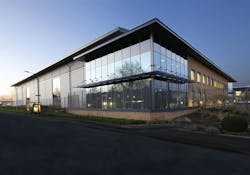Equinix wants a bigger piece of the hyperscale data center market in North America. The digital infrastructure company will be building out its hyperscale design in selected U.S. markets.
The Equinix hyperscale business segment, known as xScale, is gaining strategic importance as the growth of AI boosts demand for advanced cooling and fast access to cloud platforms. In its earnings call last week, the company said its accelerating investment in its xScale portfolio, including in the United States.
“The wave of hyperscale demand to support AI and cloud is translating into robust demand in pre-leasing activity (for xScale),” said Equinix CEO Charles Meyers. “We have a meaningful pipeline of opportunities to drive continued xScale momentum in the quarters to come.”
Until now, Equinix has only built its xScale data centers in Europe and Asia, where competition for hyperscale deployments is less intense than in the North American market.
But Equinix is now ready to bring xScale to America, and will soon open its first xScale facility in the U.S. at its Silicon Valley campus. There will be more to come.
“We are absolutely going to continue to be more aggressive in (the U.S.) market,” said Meyers. “We think there is opportunity. As you know, our tune has changed a bit on that over the last couple of years. We're hard at work on that.”
Building the On-Ramps to the Cloud
Equinix is an interconnection pioneer that has grown into a global data center colossus, operating 260 data centers and 31.5 million square feet of space across 71 cities. The company has more than 10,000 customers and generates about $8 billion in annual revenue.
The xScale program represents a fairly modest portion of that business, but is a strategic linchpin in how Equinix works with hyperscale companies like Google, Microsoft, Meta and Amazon Web Services. As hyperscale operators move larger volumes of data across global networks, proximity to major Internet intersections becomes more important.
That’s where Equinix comes in. The company says more than 40 percent of all global cloud on-ramps are housed in its facilities.
Equinix gained prominence by building highly-connected data centers in major business hubs, where networks make physical connections and exchange traffic. Equinix initially focused on colocation, in which tenants buy smaller amounts of space by the cabinet or cage. Soon larger customers began seeking entire suites of dedicated data center space.
In 2017 Equinix announced its xScale initiative, offering wholesale space to hyperscale companies to tap directly into rich ecosystems of network connections to move data around the globe.
Customer Wins for Generative AI, Liquid Cooling
Equinix has now leased 300 MWs of capacity through its xScale program, including 90 MWs in the most recent quarter. That includes strong leasing in Madrid, Milan and Warsaw in Europe, as well as Tokyo and Sydney in the Asia-Pacific market.
The customer wins included deployments supporting generative AI workloads, as well as the first hyperscale liquid cooling installation at Equinix.
In the U.S., the xScale buildout is part of a broader initiative to support the growing customer adoption of AI, which also includes boosting the liquid cooling options for customers, and teaming with NVIDIA on a managed “private AI” offering.
“The evolution of the data center design needs to respond to” the growth of GPU-driven AI workloads, Meyers said. “The more acute near-term evolution is on the (AI model) training side, because it's substantially more power dense and requires different thinking around cooling.”
Funding Growth, and Maybe Even M&A
Equinix has serious growth ambitions for xScale, with a goal of 700 MWs of capacity and $7.5 billion of investment when the platform is fully built out.
To fund these larger projects, Equinix has used joint ventures with large investors, including PGIM Real Estate and GIC, the sovereign wealth fund for Singapore. The typical structure is for the investor partner to own 80% of the equity in the JV, with Equinix taking a 20% stake.
Joint ventures with investors are becoming an important tool for data center companies to fund growth, while providing a vehicle for large investors to gain a foothold in the data center industry as it emerges as an important new asset class.
It seems likely that Equinix will consider a JV to support xScale growth in the Americas and build the facilities themselves. But with many new and growing data center operators also targeting the U.S. hyperscale market, securities analysts inquired whether the company might consider an acquisition of an existing platform.
“I think we're very focused right now on organic growth,” Meyers said on the Equinix earnings call on Feb. 14. “I just think it's tougher in terms of identifying those assets (for an acquisition). I think the multiples at which those things are trading are pretty heady, to say the least, and there’s plenty of competition for those assets.”
Equinix has made more than 15 acquisitions over the years, investing billions to add new markets and capabilities.
“If circumstances and conditions change, our balance sheet is always ready, and I think we'd be open to that,” said Meyers. “But I think our focus is probably more so on the organic side.”






